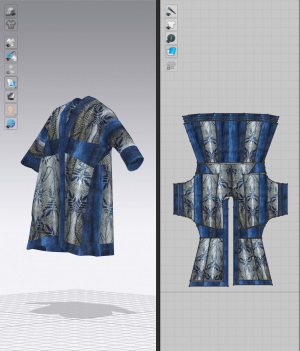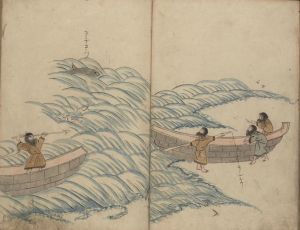FISHSKIN PATTERN-BASED GARMENTS
Before the invention of synthetic fibres, people dressed in natural materials available in their environment such as skins and hides from local wildlife. The use of fish skin to create articles of clothing is an ancient tradition shared by Arctic societies along rivers and coasts, amongst them the Ainu Indigenous Peoples of Hokkaido Island (Japan). In this research we propose to use fish skin, a waste product of the food industry, as raw material for the fashion industry under the principles of zero waste. Throughout this project we recreated an Ainu fish skin robe, using digital tools and the material itself, as a means for gaining knowledge and experimenting with the use of fish skin for garment construction. The idea behind the project draws on the Ainu Indigenous Peoples’ subsistence resourcefulness and their heritage, with regards to traditional fish skin craft practices. The project thus connects between anthropology, ethnography, and craftsmanship with current interest in fashion sustainability, advanced digital technologies, and contemporary production processes in fashion.
The Ainu garment is part of a study that hypothesises what would have happened if, during the Meji era, the Japanese, instead of making the Ainu shift from fishing to farming, had brought their own traditions, such as Katazome indigo dyeing, and blended them with the Ainu tradition of creating clothing from fish skin. The projects presented in this paper include a combination of different digital technologies and applications which were used to create a contemporary replica of an Ainu fish skin robe using a Japanese katazome indigo pattern. Firstly, we used the shape of an Ainu robe to create a fish skin module as a building block, and tested its relevancy for contemporary pattern making, and later introduced parametric design tools to test zero waste principals. We then used digital animation software to create an Ainu avatar and to recreate the fish skin garment situated in a virtual digital context. Finally following the digitally created garment, we have physically dyed in indigo the fish skins with Katazome stencils and lastly sewed a replica of the fish skin robe.
The project aims to preserve traditional Ainu fish skin knowledge and introduce new advanced digital technology to enable the design and production of zero-waste fish skins for fashion.
https://www.youtube.com/watch?v=Q78YIoiuSMUhttps://www.uantwerpen.be/en/conferences/responsible-fashion/expo/
- DALL'ALTA MODA ALLA MODA ARTICA
- THE DEEP DIG UPENN MUSEUM
- MAPPING RACE THROUGH ARCTIC FISH SKIN ARTEFACTS
- ADORNMENTS FROM THE SEA
- AMUR RIVER FISH SKIN NATURAL DYES
- ARCTIC INUKSUIT STONES
- SPIRIT AND SKIN
- ART BIO MATTERS
- NORDIC FISH LEATHER DAY
- ARCTIC PRESERVATION & DIGITAL AGE
- INDIGENOUS KNOWLEDGE
- TRADITIONAL DYES FOR FISH LEATHER
- ICOM ICME 2023 FISH SKIN COLLECTIONS
- FISH WASTE FOR PROFIT
- FISHSKIN PATTERN-BASED GARMENTS
- A VIRTUAL AINU FISHSKIN WORKSHOP
- ARCTIC INDIGENOUS FISHSKIN
- SOCIETY OF LEATHER TECHNOLOGISTS
- COSTUME SOCIETY OF AMERICA
- IFFTI CONFERENCE 2020
- DESIGN MUSEUM CONFERENCE LONDON
- KYOTO SEIKA UNIVERSITY
- CRAFT CONFERENCE ESTONIA
- CUMULUS ROVANIEMI 2019
- MILANO DESIGN WEEK
- SIMON FRASER UNIVERSITY VANCOUVER
- BRITISH COUNCIL CRAFTING FUTURES
- EU INDUSTRY DAYS BRUSSELS
- LINEAPELLE INNOVATION TALKS
- EUROPEAN LEAGUE OF THE INSTITUTES OF THE ARTS
- DWEEK BILBAO AND BRITISH COUNCIL
- BRITISH ASSOCIATION FOR JAPANESE STUDIES
- TRANSBOUNDARY FASHION SEMINAR







